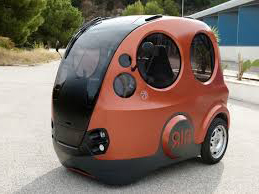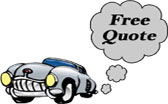Compressed air cars
A compressed air car is a compressed air vehicle that uses a motor powered by compressed air. The car can be powered only by air, or can be combined with gasoline, diesel, ethanol, or an electric plant with regenerative braking.
Compressed air cars are stored in a tank at high pressure such as 31 MPa .A air motor or compressed air engine is a type of motor which does mechanical work by expanding compressed air. Pneumatic or air motors generally convert the compressed air energy to mechanical work through either linear or rotary motion. Linear motion come from either a diaphragm or piston actuator and rotary motion is supplied by either a vane type air motor, piston air motor, air turbine or gear type motor.
Pneumatic motors range in size from hand-held motors to engines of up to several hundred horsepower. Some types rely on pistons and cylinders; others on slotted rotors with vanes (vane motors) and others use turbines. Many compressed air engines improve their performance by heating the incoming air or the engine itself. Pneumatic motors have found widespread success in the hand-held tool industry, but are also used stationary in a wide range of industrial applications. However, pneumatic motors must overcome inefficiencies before being seen as a viable option in the transportation industry.Storage tanks
In contrast to hydrogen's issues of damage and danger involved in high-impact crashes, air, is non-flammable, it was reported on Seven Network's Beyond Tomorrow that on its own carbon-fiber is brittle and can split under sufficient stress. Carbon-fiber tanks safely hold air at a pressure somewhere around 4500 psi, making them comparable to steel tanks. The cars are designed to be filled up at a high-pressure pump.In compressed air vehicles tank designs tend to be isothermal; a heat exchanger of some kind is used to maintain the temperature (and pressure) of the tank as the air is extracted.
Energy density
Compressed air has relatively low energy density. Air at 30 MPa (4,500 psi) contains about 50 Wh of energy per liter (and normally weighs 372g per liter). For comparison, a lead–acid battery contains 60-75 Wh/l. A lithium-ion battery contains about 250-620 Wh/l. The EPA estimates the energy density of gasoline at 8,890 Wh/l; however, a typical gasoline engine with 18% efficiency can only recover the equivalent of 1694 Wh/l. The energy density of a compressed air system can be more than doubled if the air is heated prior to expansion. In order to increase energy density, some systems may use gases that can be liquified or solidified.

Advantages
The principal advantages of an air powered engine is
• It uses no gasoline or other bio-carbon based fuel.
• Refueling may be done at home but filling the tanks to full pressure would require compressors for 250-300 bars, which are not normally available for home standard utilization, considering the danger inherent at these pressure levels. As with gasoline, service stations would have to install the necessary air facilities if such cars became sufficiently popular to warrant it.
• Compressed air engines reduce the cost of vehicle production, because there is no need to build a cooling system, spark plugs, starter motor, or mufflers.
• The rate of self-discharge is very low opposed to batteries that deplete their charge slowly over time. Therefore, the vehicle may be left unused for longer periods of time than electric cars.
• Expansion of the compressed air lowers its temperature; this may be exploited for use as air conditioning.
• Reduction or elimination of hazardous chemicals such as gasoline or battery acids/metals.
• Some mechanical configurations may allow energy recovery during braking by compressing and storing air.
Disadvantages
The principal disadvantages are the steps of energy conversion and transmission, because each inherently has loss. For combustion engine cars, the energy is lost when chemical energy in fossil fuels is converted by the engine to mechanical energy. For electric cars, a power plant's electricity (from whatever source) is transmitted to the car's batteries, which then transmits the electricity to the car's motor, which converts it to mechanical energy. For compressed-air cars, the power plant's electricity is transmitted to a compressor, which mechanically compresses the air into the car's tank. The car's engine then converts the compressed air to mechanical energy.







